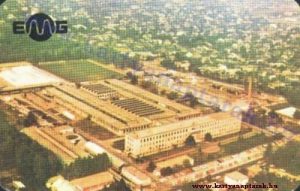Electronic Measuring Instruments Factory
Budapest, District XVI, Cziráky Street 26-32
In 1950, much more equipment had to be delivered than Orion's small instrument department could handle. In the spring of 1950, a few engineers, technicians, and workers took it upon themselves to leave Orion and create the basis for the mass production of modern electronic devices within the framework of the domestic instrument industry.
- György Striker, chief engineer
- Arpad Klatsmanyi,
- Zoltán K. Szabó, CEO from 1986 to 1995
Year |
Number of people |
|---|---|
| 1951 | 640 |
| 1955 | 975 |
| 1960 | 1.427 |
| 1965 | 2.401 |
| 1967 | 2.583 |
| 1968 | 2.954 |
Year |
Revenue (HUF) |
|---|---|
| 1951 | 28.000.000 |
| 1960 | 145.000.000 |
| 1970 | 469.000.000 |
| 1974 | 776.000.000 |
| 1986 | 1.413.000.000 |
1954-1956 Amateur radio measuring instruments (oscillator, oscilloscope, signal generator, tube voltmeter. A family of industrial measuring instruments was also developed, such as strain gauges, moisture meters, pH meters, density meters. Medical testing devices (electrocardiograph, Audiometer)
1957 Serial production of nuclear measuring devices. Portable GM tube radiation meter, radiation counter, radiation averager and other nuclear devices. Portable TV signal and image pattern generator, TV device tester, dual-beam oscilloscope, time measuring oscilloscope for TV technology.
1960 Medical instruments (electrocardiograph, phonocardiograph, ballisto-dynam. cardiograph, electromanometer, rheograph, electroencephalograph, pulso-tachometer)
Transistor measuring devices
1962 Logic circuits for building digital control and regulation systems and data processing equipment. Development of Hunor electronic digital computers began.
1965 Development of a modular digital computer.
EMG 830 computer
1970 Multi-channel analyzers. Programmable digital voltage meters, digital frequency and time meters, and pulse generators can be integrated into fully automatic systems.
1967-1972 Development of complex product families, which, due to their variability, are suitable for performing most measurement tasks occurring within a specific field of expertise.
1972-1977 The EMG Plan Control (EMG PC) production management system was developed together with Comporgan
1974 Programmable electronic calculators. EMG 666
In 1978, the Hunor brand CNC machine tool control family was developed.
On July 1, 1963, the Esztergom factory of the Factory of Electrical Devices and Measuring Instruments was attached to the factory. Initially, it produced only relays, but then the production of medical diagnostic instruments and then electronic measuring devices came to the fore. By 1966, the increase in production required the expansion in Sashalma. Three new assembly halls were built, and the Esztergom factory was also expanded.
After the change of regime, the factory was liquidated starting in 1991 at the initiative of the tax office due to production tax debts. The EMG industrial park and the Kiserdő Clinic operate in its place.
EMG developed the first digital, four-basic-operation, automatic desktop calculator (HUNOR), and then, in the second half of the sixties, the EMG 803 transistorized general-purpose computer.
The highest number of employees was 3,100, including 240 engineers.
During its operation, EMG has successfully registered 237 patents with the Hungarian Standards Office.
- EMG 830 computer system
- EMG presents itself at the iTF event on April 25, 2012.
- EMG 830 in ITK
- EMG studies
- Excerpts from the history of EMG
- The beginnings of computer technology in Hungary
- The history of the Electronic Measuring Devices Factory (EMG)
- EMG's IT development and manufacturing activities
- The creation of EMG - the role of György Striker
- EMG software
Created: 2016.06.25. 17:16
Last modified: 2025.08.30. 12:46

